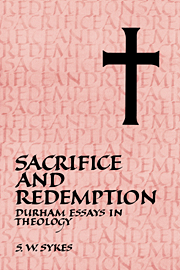Book contents
- Frontmatter
- Contents
- List of contributors
- Prefatory note
- Introduction
- PART I
- PART II
- PART III
- PART IV
- 15 The semantics of sacrifice
- 16 Outline of a theology of sacrifice
- 17 Christ died for us: reflections on the sacrificial language of salvation
- Index of biblical and ancient references
- Index of persons
17 - Christ died for us: reflections on the sacrificial language of salvation
Published online by Cambridge University Press: 10 March 2010
- Frontmatter
- Contents
- List of contributors
- Prefatory note
- Introduction
- PART I
- PART II
- PART III
- PART IV
- 15 The semantics of sacrifice
- 16 Outline of a theology of sacrifice
- 17 Christ died for us: reflections on the sacrificial language of salvation
- Index of biblical and ancient references
- Index of persons
Summary
Jesus Christ, the Apostles’ Creed states, ‘suffered under Pontius Pilate, was crucified, dead and buried’. The account of his death could hardly be more sober. The events leading to his death and burial are carefully listed. But nothing is said to bring out the vital importance which Christians attach to his death. The events as such seem not to point beyond themselves. Only the wider context of the whole Creed and the contextualization of these events in a narrative sequence that comprises not only Jesus’ life and death but also the acts of God in his conception, resurrection and ascension give a clue as to their saving significance. To express the latter, it is not sufficient to mention these events; one has to rehearse the whole story told by the Creed.
The Nicene Creed, in contrast, does not content itself with these indirect pointers. It expressly mentions that Christ ‘for us men, and for our salvation came down from heaven’ and that he ‘was crucified for us under Pontius Pilate, suffered and was buried’ (my italics). The saving significance of the whole sequence of events in general and of Christ's crucifixion in particular is explicitly stated – it was for us, for our salvation, that all this happened. Jesus Christ not only died, he died for us. The sober rehearsal of his story is thus emphasized to be more than a biographical sketch of the history of this particular person long since past.
- Type
- Chapter
- Information
- Sacrifice and RedemptionDurham Essays in Theology, pp. 299 - 325Publisher: Cambridge University PressPrint publication year: 1991



